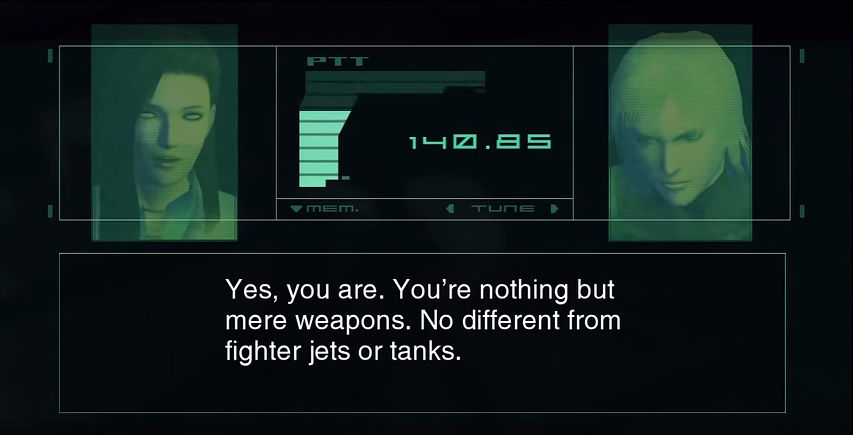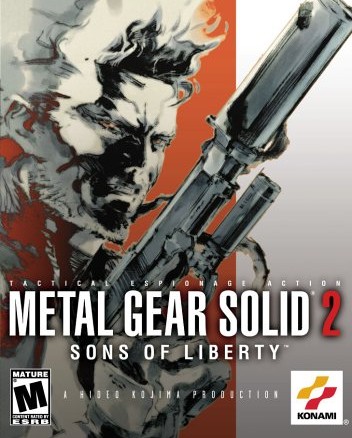The Metal Gear video game franchise has a reputation for excellence in storytelling and innovative gameplay. It is also comically difficult. Join Deadshirt Editor-in-Chief and absolutely terrible video gamer Dylan Roth as he plays through the entire Metal Gear canon in anticipation of the long-awaited Metal Gear Solid V: The Phantom Pain, out this fall.
I’m running naked through a top secret compound created by the shadow government, covering my balls, and doing somersaults to avoid guards. Meanwhile, my commanding officer is on my radio, spouting increasingly incoherent nonsense. His voice is getting distorted, like HAL singing “Daisy.” He says my girlfriend has been cheating on me. He says I should turn off my game console. I stop for a moment and consider that this may be the closest I’ve ever come to madness.
This is Metal Gear Solid 2: Sons of Liberty.
MGS2 may be the most insanely complex story I’ve ever absorbed, in any medium. Combine the twisty-turny plotting of True Detective, the philosophical weight of the Matrix trilogy, the metatextuality of Grant Morrison’s Animal Man, and more double-crosses than the third Pirates of the Caribbean movie, and you might come close to the level of mindfuckery offered by Sons of Liberty. It is a goddamn Twilight Zone episode of a video game, with twists that you could never see coming and yet seem totally inevitable. It’s cohesively absurd in a manner usually reserved only for top-shelf anime, frustrating and mind-boggling and just delightful.
Metal Gear Solid 2: Sons of Liberty was first released on the PlayStation 2 in 2001 to nearly universal acclaim. It received an expanded cross-platform release, MGS2: Substance, the following year, and has since been remastered in HD for the PS3, PSP, and Vita. For my purposes, I played the HD version included in the Legacy Collection for the PS3, which includes many of the expanded features from Substance.
Many fans and critics argue that Sons of Liberty is the peak of the franchise (at least until The Phantom Pain is released in two weeks’ time), with the most complex story and slickest gameplay. As much as I love the first Metal Gear Solid, I can’t argue against this game being the best I’ve played in the series so far.
Without further ado, let’s get to the wackness.
Story
SPOILERS AHEAD.
Sons of Liberty begins in 2007, two years after Snake defeated Liquid Snake and Metal Gear REX on Shadow Moses Island in the previous game. Since the Shadow Moses Incident, there has been massive proliferation of Metal Gear production across the globe—every major military power now has their own program for developing giant nuclear-ready walking battle tanks, and there’s an arms race to create the biggest and baddest. Superspy Solid Snake and his techie sidekick Hal “Otacon” Emmerich have quit the US military and gone to work for an NGO called Philanthropy, whose goal is to put a stop to Metal Gears around the world, mostly through spreading information online.
Snake infiltrates a US Navy tanker to photograph a secret new Metal Gear prototype and expose its existence to the world. But while he’s aboard, an old familiar foe—the mercenary Revolver Ocelot—steals the prototype and sinks the ship. Having been sighted by an Army drone on the deck of the tanker, Solid Snake is framed for the attack and must go into hiding.
Two years later, FOXHOUND sends their new Snake (this codename is routinely given to their sneaking expert) to rescue a group of hostages—including the President of the United States—from Big Shell, an environmental cleanup facility off the shores of Manhattan over the site where Solid Snake allegedly destroyed an oil tanker. (We know that’s not true because we were there, but the new kid doesn’t know that.) The hostages are being held for ransom by a terrorist group called the Sons of Liberty, made up of members of the counter-terrorist group Dead Cell, and are said to be led by Solid Snake himself, though that shouldn’t be possible; by all accounts, Solid Snake is dead.
To avoid confusion, FOXHOUND’s new Snake is given a new codename for the duration of the mission: Raiden (RY-den). Raiden has trained extensively in virtual reality, but has very little experience in the field and comes across as pretty green from the very beginning, but the extent of his naivety doesn’t truly come to light until curtain after curtain of deceit is drawn for the player.
Over the course of 36 hours, Raiden discovers that his mission is a smokescreen designed to hide the terrorists’ real objective, then that this too is a charade, and that the real truth is more terrifying and far-reaching than he could have possibly imagined. His mission, his entire life, is a lie perched atop an endless tower of bigger, older lies. Nearly every character in Sons of Liberty is being either subtly or overtly manipulated by another character, who is likewise also being manipulated. The magnitude of deception at work here is so grand that I actually needed to enlist the aid of Deadshirt contributor Yen Nquyen to create a graphical representation.
To detail the entire plot of Sons of Liberty could very well take all day, but here’s the broad strokes: Big Shell isn’t an environmental cleanup station, it’s a cover for Arsenal Gear, a giant mobile fortress/computer designed to manipulate the spread of information across the internet for the purposes of control. Arsenal Gear is the latest effort by a secret shadow organization called The Patriots, who are the puppet masters behind the actions of the “real” US government. The Patriots have been able to quietly manipulate the public for decades, but the internet has made it more difficult for them to write the history that suits them, so they created Arsenal Gear as a way to target and destroy any information that doesn’t suit their ends, ensuring their continued rule.
The Patriots are influencing nearly every character in Sons of Liberty whether their pawns know it or not. Solidus Snake—the secret third clone of Big Boss who’s the leader of the titular terrorist group—thinks attacking Arsenal Gear is his own idea, but he’s actually been maneuvered here by Revolver Ocelot, who’s actually an agent working directly for the Patriots. Solidus, who used to be the freakin’ PRESIDENT before he crossed the Patriots, has been flushed out so that he can be eliminated by Raiden, who as an agent of FOXHOUND is an unwitting soldier for the Patriots. The entire exercise also serves as a test to see if Raiden can be subtly reprogrammed into being the next Solid Snake-caliber “perfect soldier,” and to configure a program designed to better control the public.

Arsenal Gear’s A.I. taunts you using the voice and visage of Raiden’s lady love…who turns out to be a Patriot spy.
Ultimately, even as you/Raiden learn of the ghoulish extent to which you’re being used, you still have no choice but to carry out their will and kill Solidus as ordered.
Sons of Liberty is separated into two chapters: “Tanker,” in which you play as Solid Snake infiltrating the Navy vessel for Philanthropy, and the much longer “Plant,” where you play as Raiden unraveling the massive Patriots conspiracy. “Tanker” seems to set up that Metal Gear Solid 2 will be another story about preventing nuclear Armageddon in the form of a giant mech suit, but “Plant” reveals that this is a far more contemporary story. In the digital age, the power of massive governments and corporations is threatened by the free distribution of information, and the most terrifying weapon a government could have is the ability to control that information. The stakes of previous Metal Gear games are the threat of nuclear war; what’s at stake in Sons of Liberty is all of history, and our ability to speak and think for ourselves.
This message is actually forecast, in hindsight, in the first chapter: Snake’s mission isn’t to kill or destroy anything, it’s to take pictures and spread the truth. That’s what the Patriots fear more than anything, the reason why Arsenal Gear exists.
Gameplay
While Metal Gear Solid felt like a 3D update of Metal Gear 2: Solid Snake, Sons of Liberty truly feels like a game designed for modern consoles and sensibilities. While the series’ signature stealth-first gameplay remains excellent, combat in MGS2 is vastly improved over earlier installments. Sons of Liberty is the first game Metal Gear game to include first-person toggle at launch, making precision shooting possible with any weapon, not just a sniper rifle. Hand-to-hand combat is also slicker, and feels a lot less redundant than it did in Metal Gear Solid, where just the sound of repetitive three-hit combos could drive a player up the wall during some missions. While MGS2 still relies a lot on stationary cameras, requiring the player to anticipate and adapt when turning corners or entering rooms, it feels less jarring here than in the first Solid title. This game also adds a small portion of swordfighting toward the end of the game, but isn’t functionally all that different from hand-to-hand action. (I expect to get a very different swordplay experience out of Metal Gear Rising: Revengeance, which I’ll be reviewing in Part 8 or 9.)
What’s amazing about Sons of Liberty from a design standpoint is how much gameplay is packed into a relatively small play area. Most of the game takes place in the Big Shell complex, which is made up of two dozen small three-story pods connected by a series of catwalks. While there’s a fair amount of retreading back and forth between pods, new gameplay elements are introduced consistently to keep the game feeling fresh despite the small environment. The variety goes beyond simply being able to open new doors with acquired key cards; your goals change constantly, from sneaking into tight spots to disarming bombs to tricking security cameras. You may be walking up and down the same buildings and causeways, but it feels a little different each time, and just when you’re getting tired of your surroundings, another part of the complex will open up, and the whole game will change again.
Kojima makes a brave decision to devote most of the game’s play time to new character Raiden rather than series mainstay Solid Snake, and I’m of the opinion that it pays off in a big way. Not only does employing Raiden’s more agile sneaking style help to differentiate Sons of Liberty from the previous game, but it also allows for the player to play the role of shadow government patsy without having to make Snake look like an idiot. By becoming a non-player character, Snake gets to always remain one step ahead, coming across as far more of a badass than he ever can in the hands of the player, and the player gets to benefit from Raiden’s relative ignorance. It also adds a tasty layer of subtext to the game’s story: Snake is beyond your control, beyond the Patriots’ control, while Raiden’s fear that his life isn’t his own and that he’s just an instrument of someone else’s will is geniunely true, because the player controls his every move.
Fans would get only one last opportunity to play as the heroic Solid Snake, in this game’s direct sequel Metal Gear Solid 4: Guns of the Patriots. But first, we’re treated to a prequel, Snake Eater, the first Metal Gear installment to center not on Solid Snake, but on his “father,” the man who would be Big Boss.
Special thanks to Jenn W. for lending me her PS3 when mine exploded, allowing me to continue this series.
Come back next Friday as we leap back to the 1960s for Metal Gear Solid 3: Snake Eater!







